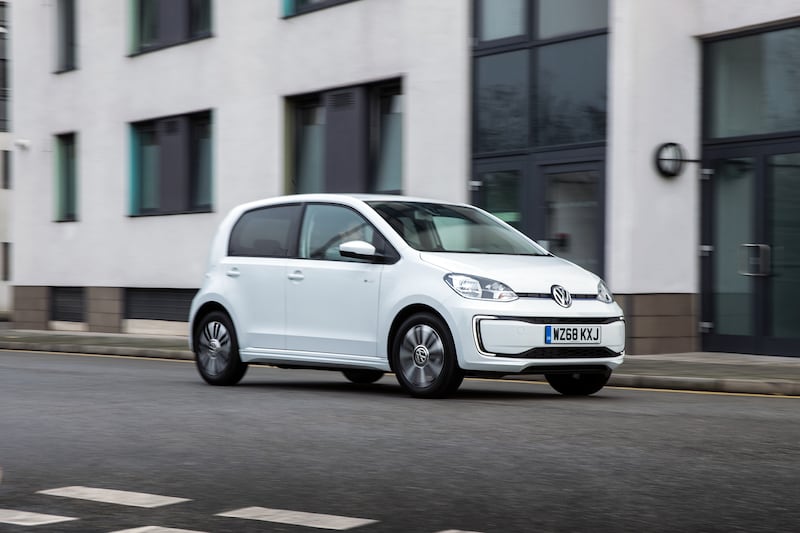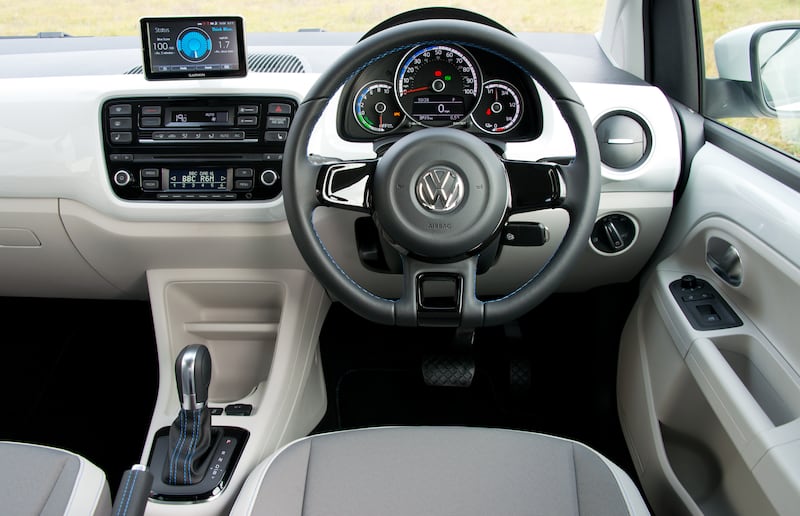It genuinely was a sad day when the Volkswagen Up (and its Seat Mii and Skoda Citigo cousins) were taken off sale in Ireland. It was, in many ways, an especially sad indictment of the way that legislation is pushing the car industry at the moment. The government overlords are calling for more and more standardised safety systems, which drives up prices and development costs, and makes small, light, simple and efficient cars such as the Up more difficult to make money from.
Car companies are, after all, companies so in the face of such legislation it’s easier by far to make bigger, heavier, more expensive cars and sell those instead, at a healthier profit margin.
Which is, of course, madness. We have never been more in dire need of small and economical cars to help combat ever-rising CO2 emissions. Let’s face it, if we’d all bought Ups instead of Tiguans in the last 10 years the climate crisis would be at a far lower ebb than it is.
Thankfully, though, the Up is now back and it has gone electric. In fact, this is the e-Up, and while it’s true that’s going to be a badge that’s difficult to sell in the north of England, linguistically speaking, it’s a hugely welcome return here in Ireland.
READ MORE

Not least because it’s one of the most affordable electric cars you can currently buy. It’s true that the most basic version of the Fiat 500e undercuts the e-Up’s cheapest €27,813 price tag, but to do that the Fiat has to make do with a tiny 24kWh battery, limiting it to a range of just 190km.
By contrast, the e-Up’s battery has a 32.3kWh capacity, which is about the same size of battery that you get in a plug-in hybrid Range Rover. The big, luxury SUV can squeeze about 110km of EV range out of a battery that big. The e-Up can do considerably better than that – how does 253km grab you?
It seems to be a realistic range, too. Obviously, given its size, the e-Up is aimed more at intra-urban use than it is tackling long, cross-country runs, but – just as with the old petrol-engined Up – the e-Up is one of those small cars that feels entirely at home on the motorway. The extra weight compared with the combustion-engined versions probably helps, but even at 1,200kg the e-Up is one of the lightest electric cars you can currently buy.
Hop into the outside lane and cruise at 120km/h and you will see a reduction in range, but based on our test drive I’d say about 190-200km at motorway speeds is just about possible. Around town, and on rural roads, the e-Up should easily hit its claimed range, or at least get very close to it – let’s say about 230km, to allow for a little leeway. It will charge only at 37kW speeds from a fast DC charging point, but that’s still enough to give it an 80 per cent top-up in less than 30 minutes.

The cabin is a particular high point of the e-Up. It’s just so simple. No big, daft touchscreens – instead there’s a clamp into which your mobile phone slots, and you connect that to the car’s systems via Bluetooth. There’s a straightforward three-dial instrument binnacle in front of you, with a small digital display that gives you battery range and other trip computer information. There are utterly simple, physical, air-conditioning controls, and in the tiny radio display screen, there’s the world’s smallest and cutest reversing camera.
Not that you’ll need it much. You can practically lean back and touch the e-Up’s rear windscreen from the driver’s seat, so parking is an utter doddle, and with its light steering the car feels completely at home on tight and narrow city streets. Its turning circle is almost laughably tiny.
Does all that mean it’s impractically small inside? No, not really. the back seats are roomy enough for tall adults, as long as you don’t intend driving to the far end of the country (and even then, they could get out and stretch while you’re topping up the battery en route). The boot is small, just 251 litres, but it’s enough for a few bags of groceries, or a couple of carry-on suitcases. There’s even a small bit of underfloor storage, so your charging cables don’t eat into luggage space too much.
Honestly, driving the e-Up has come as little short of a blessed relief after a long period of testing ever bigger, ever heavier SUVs and crossovers – electric and otherwise. It’s a stark and welcome reminder that a minimal car doesn’t have to be minimalist; it can still look and feel rather cool, inside and out, and still provide enough comfort and refinement that you don’t feel as if you’re driving a motorised hair shirt.

Mind you, the e-Up’s days are already numbered. BYD is about to introduce the new Dolphin EV hatchback into Ireland, and while that’s a much larger car with a much longer range (up to 420km), it’s going to be priced at about the same level as the e-Up, which probably doesn’t bode well for the VW’s sales prospects.
Beyond that, VW is plotting two new affordable compact EVs. We already know that the ID.2all concept will be Polo-sized on the outside, and Golf-sized within, will have a circa-400km range and should be priced at around the same level as this e-Up when it arrives in 2026. VW is also working on a possible ID.1, which should be able to offer 300-350km ranges for less than €20,000 when (well, if) it arrives not long after the ID.2all. Equally, Dacia is limbering up to bring us its Spring EV, with a potential 300km range, and a possible sub-€20,000 price tag, by the end of 2025.
Numbered days? Yes, likely so. But the days between now and then would be so much better spent in this diminutive, but dogged, little EV. The e-Up is a car that just shows how wrong most people get it when they buy a new car.
Lowdown: Volkswagen e-Up Style
Power: 61kW e-motor developing 83hp and 212Nm of torque, powering the front wheels via a single-speed automatic transmission.
Electric consumption: 14.7kWh/100km (WLTP).
Electric range: 253km (WLTP)
0-100km/h: 11.9 sec.
Price: €28,833 as tested, e-Up starts from €27,813.
Our rating 4/5.
Verdict: One of the cheapest electric cars you can buy. Also one of the best.













